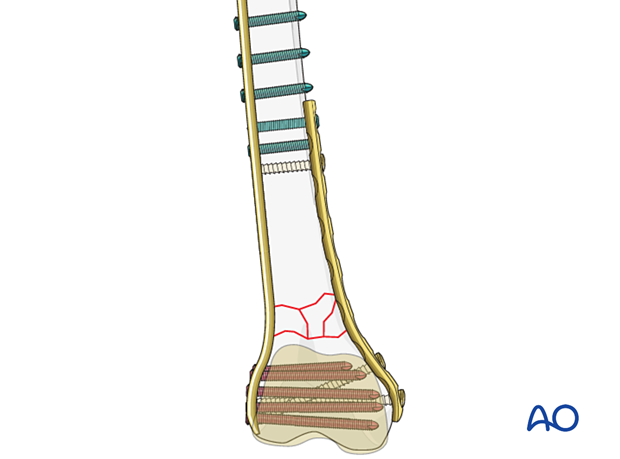Double plate
1. Principles
This technique provides more robust fixation than single lateral plating at the possible expense of fracture devitalization. This might be desirable to prevent fixation failure in patients who might place an excessive load on the fixation. It could also be desirable to prevent fatigue failure of implants in patients with excessively slow fracture healing.
Double plating uses bridging fixation because of metaphyseal comminution.
As most surgeons have more experience in lateral plate fixation (compared to medial fixation) most surgeons will perform reduction and plate fixation on the lateral side first.
The medial incision is then made, and a surgeon contoured plate added to provide additional stability.

2. Implant selection
Plates selection
The lateral side is usually plated with a precontoured locking plate system.
Precontoured plates do not exist for the medial side. Therefore, a surgeon contoured LCP is used.

Options for additional stability
Additional stabilization can be achieved with locking and nonlocking screw fixation above and below the fracture site.
If there is no room for bicortical screw fixation, different options may be used around the component stem to secure the plate:
- Unicortical locking screw fixation
- Cerclage cables integrated into the plate
- Locking attachment plate
For additional details on these implants please refer to adjunct plate options.
3. Preparation and approaches
Patient positioning
The patient is positioned supine.
Approaches
The lateral plate is usually inserted through a minimally invasive approach.
The medial plate is usually inserted through an open approach.
4. Reduction
The fracture is reduced and stabilized using the standard lateral bridge plate technique.
Supplementary, medial fixation is then performed on the reduced fracture.
5. Fixation
Plate contouring
A malleable template is used to precisely plan the contour of the LCP to fit the medial aspect of the reconstructed distal femur. A bending press is required for careful contouring of the plate.
The length of the plate is less dogmatic as it is only biomechanically supporting the fixation on the lateral side. Usually this plate should have at least two bicortical screws proximally and distally. Locking screws would be preferred in the metaphysis, if possible.

The contoured plate is placed on the medial distal femur to check for accurate contouring.

If the contouring is satisfactory, the plate is fixed to the bone by first inserting a screw in the proximal screw hole.

Then, the most distal screw is inserted with fluoroscopic review in all planes to ensure that the plate position is optimal.

The final two screws are inserted. The distal femur with two plates applied has many screws in the distal articular block. The screw traffic is heavy, but these fractures demand biomechanical stability.

6. Aftercare
This fixation technique will allow early full weight bearing postoperatively.
Knee bracing is not essential and should be considered optional for patient comfort.













